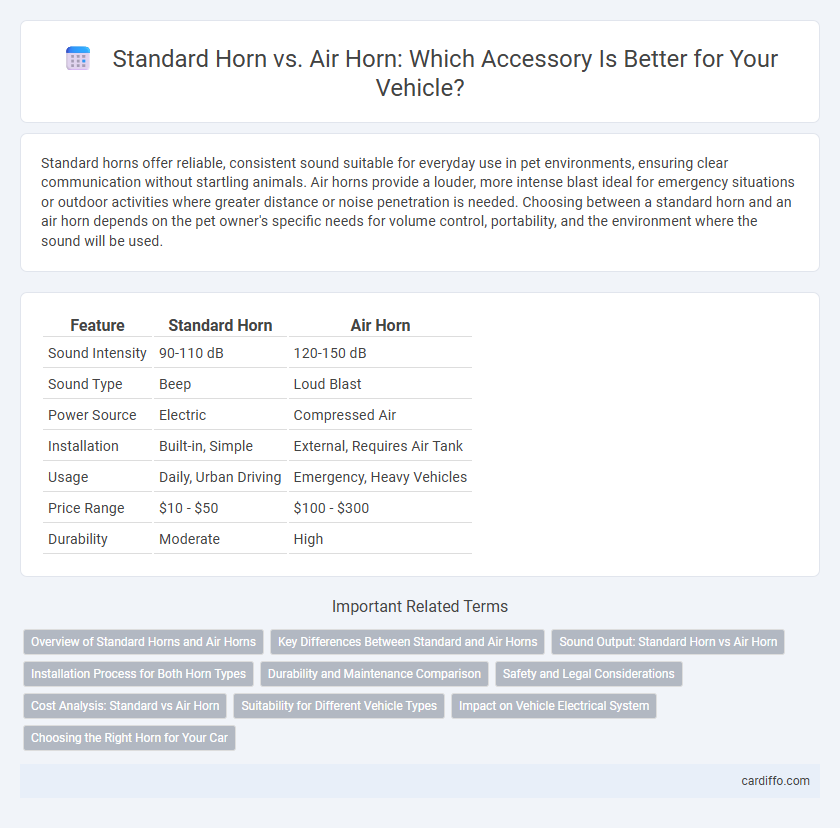Standard horns offer reliable, consistent sound suitable for everyday use in pet environments, ensuring clear communication without startling animals. Air horns provide a louder, more intense blast ideal for emergency situations or outdoor activities where greater distance or noise penetration is needed. Choosing between a standard horn and an air horn depends on the pet owner's specific needs for volume control, portability, and the environment where the sound will be used.
Table of Comparison
| Feature | Standard Horn | Air Horn |
|---|---|---|
| Sound Intensity | 90-110 dB | 120-150 dB |
| Sound Type | Beep | Loud Blast |
| Power Source | Electric | Compressed Air |
| Installation | Built-in, Simple | External, Requires Air Tank |
| Usage | Daily, Urban Driving | Emergency, Heavy Vehicles |
| Price Range | $10 - $50 | $100 - $300 |
| Durability | Moderate | High |
Overview of Standard Horns and Air Horns
Standard horns typically emit a single-tone sound produced by an electric diaphragm, offering a consistent and moderate volume ideal for everyday vehicles. Air horns use compressed air to generate a loud, multi-tone blast that is significantly more attention-grabbing, often installed on trucks, trains, and emergency vehicles for enhanced audibility. The choice between standard horns and air horns depends on the required sound intensity and application environment.
Key Differences Between Standard and Air Horns
Standard horns operate using an electromagnetic mechanism that produces a single-tone sound, typically ranging between 300 to 500 Hz, making them suitable for everyday vehicle use. Air horns utilize compressed air to generate a louder, multi-tone sound often exceeding 120 decibels, preferred in trucks and emergency vehicles for enhanced audibility over long distances. Key differences include sound pressure level, power source, installation complexity, and intended usage scenarios, with air horns providing superior volume and tonal variety compared to standard horns.
Sound Output: Standard Horn vs Air Horn
Standard horns typically produce sound levels ranging from 90 to 110 decibels, designed for daily urban driving with clear but moderate noise output. Air horns generate significantly louder sound, often exceeding 120 decibels, using compressed air to produce a sharp, attention-grabbing blast ideal for trucks and emergency vehicles. The greater sound intensity and tonal distinctiveness of air horns enhance long-distance audibility and reduce the risk of being unheard in noisy environments.
Installation Process for Both Horn Types
Standard horns typically feature a straightforward installation process involving direct wiring to the vehicle's electrical system and mounting near the radiator or grille. Air horns require more complex installation, including an air compressor, air lines, and a pressure tank, which often necessitates additional mounting space and secure placement within the engine bay or undercarriage. Proper electrical connections and air line routing are essential for optimal performance and longevity in both horn types.
Durability and Maintenance Comparison
Standard horns typically feature sealed metal construction, providing moderate durability and requiring minimal maintenance, mainly periodic cleaning to prevent corrosion. Air horns boast robust, heavy-duty components designed for extended lifespan under harsh conditions, but they demand regular checks of the air compressor and tubing to maintain optimal performance. Durability favors air horns in industrial or outdoor environments, while standard horns excel in low-maintenance applications with occasional use.
Safety and Legal Considerations
Standard horns emit a sound within legal decibel limits to ensure safety and compliance with traffic regulations, minimizing the risk of noise pollution and fines. Air horns produce significantly louder sounds, which can enhance alertness in emergency situations but may violate noise ordinances or vehicle codes in some jurisdictions. Selecting a horn involves balancing audibility for safety with adherence to local legal standards to avoid penalties.
Cost Analysis: Standard vs Air Horn
Standard horns generally offer a more cost-effective solution with prices typically ranging from $10 to $30, making them ideal for budget-conscious buyers. Air horns, while significantly louder and providing enhanced sound output, come at a higher price point, often between $50 and $150, due to their complex components and installation requirements. When considering long-term investment, standard horns require minimal maintenance, whereas air horns may incur additional costs related to compressors and air supply systems.
Suitability for Different Vehicle Types
Standard horns provide a balanced sound output suitable for motorcycles, sedans, and compact cars, where moderate noise levels comply with urban noise regulations. Air horns deliver a louder and more attention-grabbing sound, making them ideal for trucks, buses, and emergency vehicles requiring enhanced audibility in noisy environments. Selecting between standard and air horns depends on vehicle size, typical operating conditions, and legal sound limits to ensure safety and regulatory compliance.
Impact on Vehicle Electrical System
Standard horns typically consume less electrical current, usually around 5-10 amps, making them easier on a vehicle's electrical system and reducing the risk of battery drain or fuse blowouts. In contrast, air horns often require higher voltage and current, sometimes exceeding 15 amps, which can strain the electrical system and may necessitate additional relays or upgraded wiring to prevent overload. Proper installation and compatibility with the vehicle's electrical capacity are crucial to ensure optimal performance and avoid damage.
Choosing the Right Horn for Your Car
Choosing the right horn for your car depends on sound intensity, durability, and installation ease. Standard horns offer minimum decibel levels around 100 dB, making them suitable for urban environments, while air horns provide louder sound output exceeding 120 dB, ideal for high-noise areas and safety alerts. Consider vehicle type and local regulations to ensure compatibility and compliance when selecting between standard and air horns.
Standard horn vs Air horn Infographic

 cardiffo.com
cardiffo.com